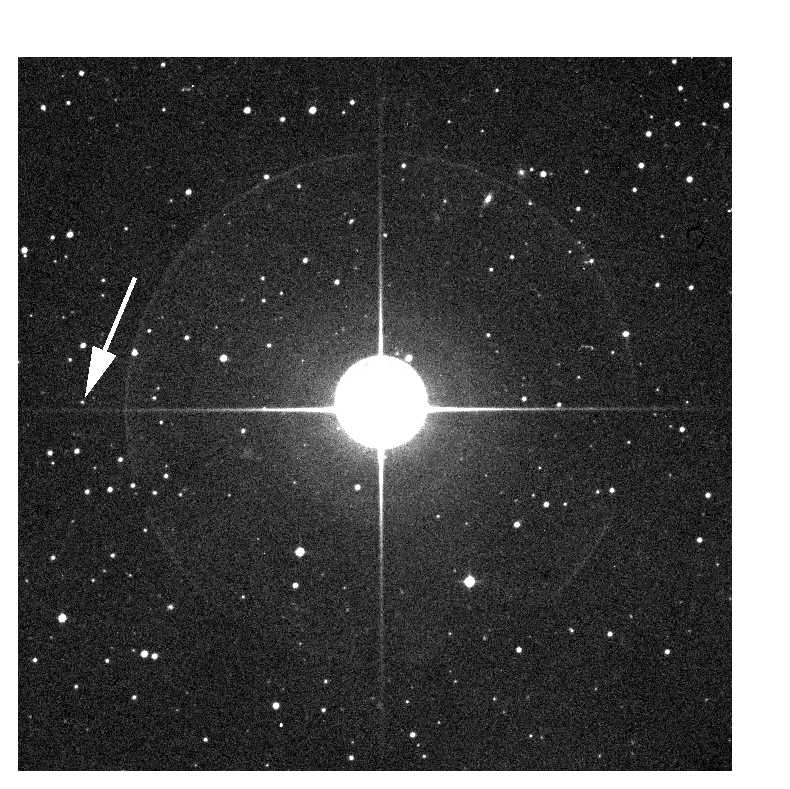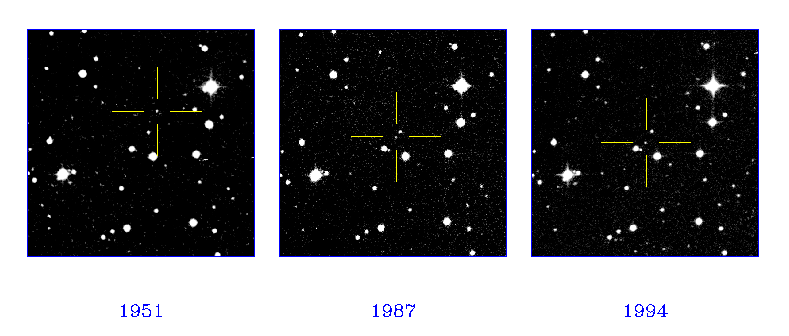Recent Astronomical highlights from SuperCOSMOS
(most recent first)
Discovery of the nearest brown dwarf to the Sun (2003)
A team of European astronomers have been using
SuperCOSMOS Sky Survey
data to search for very nearby, low luminosity stars. Using the UKST I band
data and the recently released two-micron all sky survey (2MASS) they found
a common proper motion companion to the very nearby star Epsilon Indi
(which is around 10 light-years away from the Sun).

This image from the UKST I band survey show the primary star Epsilon Indi A
(very bright, central star)
and it's newly discovered companion (B; arrowed). Components A and B share a
common proper motion, and a spectrum of the much fainter brown dwarf shows
that it is a member of an extremely rare class of very low luminosity star, the
T dwarfs. Currently, Epsilon Indi B is the nearest known brown dwarf to the
Sun.
|
For more information, see
Scholz et al., A&A, 398, 29 (2003).
Note added later: After
follow-up observations, it turns out that Epsilon Indi B is in fact
a binary itself. The triple system Epsilon Indi is now known to consist of
the primary plus a T1/T6 brown dwarf binary. This remarkable discovery will
enable the direct mass measurement of two brown dwarfs within the next
decade or so via astrometry of the orbiting pair.
For much more detail concerning this discovery, see
McCaughrean et al., A&A, 413, 1029 (2004) .
Measurement of intrinsic alignments in galaxy ellipticities (2002)
A team of Edinburgh astronomers have used the
SuperCOSMOS Sky Survey
to measure a very weak correlation signal between the alignment of galaxy
ellipticites on small scales. In a tour-de-force of data processing
and statistical estimation, the team (lead by Michael Brown and Andy
Taylor) measured
the alignment of 2 million galaxy ellipticities in the local Universe
over a range of scales, and found for a magnitude cut of
Bj=20.5, corresponding to a median galaxy redshift of
z around 0.1, that the galaxy
ellipticities exhibit a non-zero correlation over a range of scales
between 1 and 100 arcmin.
Considering the low median redshift of the galaxies in the sample and
hence the relatively low effective cross-section for lensing of these
galaxies by the large-scale structure of the Universe, they propose that
they have detected an intrinsic alignment of galaxy ellipticities.
Comparison with recent analytical and numerical predictions
made for intrinsic galaxy alignment found good agreement.
For much more detail concerning this discovery, see
Brown et al., MNRAS, 333, 501 (2002) .
The UK Schmidt Panoramic Deep Fields (2001)
A team of Australian astronomers have used SuperCOSMOS scans of UK Schmidt
photographic plates to create a deep, coadded stack of data that rivals
intermediate sized, large format CCD cameras in terms of depth, but that
out-performs them in terms of field-of-view.
The Panoramic Deep Fields consist of a multicolor survey of two 5x5
degree Schmidt fields with limiting magnitude of
Bj=23.5. The data have been used to measure the clustering of AGN and
galaxies at intermediate redshift; the evolution of radio galaxies at
intermediate redshift; and the clustering of colour-selected galaxies.
For much more detail concerning the Panoramic Deep Fields and astronomical
applications of the data, see the following papers by lead author M.J.I.
Brown:
AJ 122 26 (2001);
AJ 121 2381 (2001); and
MNRAS 317 782 (2000).
The SuperCOSMOS Sky Survey goes live (1999)
The first release of the online SuperCOSMOS Sky Survey was announced in
June 1999. The first installment of data consisted of around 4000 square
degrees of data in three colours (BRI), one colour being available at
two epochs. The ambitious sky survey program ultimately aims to cover
the entire sky by using the UKST/ESO collections in the southern hemisphere
and the POSS-I E and POSS-II BRI collections in the north.
For more information, consult the
SuperCOSMOS Sky Survey homepage.
Precision astrometry from SuperCOSMOS (1998)
The SuperCOSMOS team have completed a detailed analysis of the system for the
purpose of ascertaining the accuracy of SuperCOSMOS for precision astrometry, and
in particular for proper motion studies. They demonstrate that the system has
intrinsic machine repeatability and absolute positional accuracy having single
co-ordinate, single measurement errors of sigma less than 0.1 microns and sigma~0.15
microns respectively. In addition, measurement errors from the system are shown
to be small relative to emulsion noise dominated errors from measurements of
different plates of the same field.
For the purposes of relative astrometry of stars, this will enable, for
example, the determination of relative proper motions to an accuracy of ~ a few milliarcseconds
per year using the first and second epoch survey Schmidt plate material in both the
northern and southern hemispheres. There is now a great potential for studies
in, for example, stellar kinematics; Galactic formation, structure and evolution;
and mean space motions of satellite galaxies and globular clusters, to name but a few topical
research area.
For more details, see
Hambly et al., MNRAS, 298, 897 (1998).
Coolest known degenerate star detected? (1997)
A team of astronomers from the ROE, ING and Leicester University have detected
(from its high proper motion - 1.3 arcsecs yr-1) a star which, from
follow-up photometry and spectroscopy, reveal it to be an extremely cool degenerate
(T ~ 3900 degrees Kelvin), and is possibly the coolest degenerate star
currently known.

These images are digitised scans of photographic plates showing the
motion of WD0346+246 over 43 years. The epochs of the three images are
(from left to right) 1951.91, 1987.92 and 1994.99. The first image
uses the Red (0.7 microns) passband, while the last two are in the I
(0.8 microns) passband.
|
For more information, see
Hambly, Smartt & Hodgkin, ApJL, 489, 157 (1997).
Note added later: As it turned out,
this star was the first of a new class of ultracool
white dwarfs to be discovered. For more information about this fascinating
object, see
Hodgkin et al., Nature, 403, 57
(2000).
Another large group of quasars discovered - evidence for cellular structure
and voids as far back as z~1.5?
In recent years, quasars being typically much brighter than galaxies have been used
to probe the structure of the Universe at early times, between the smooth
beginning and the highly structured present (clusters, superclusters, filaments,
sheets, voids and quasi-periodic spacings). These observations have revealed
rare instances of extremely large structures - the large quasar groups - with
sizes ~100-200h^-1 Mpc, making them the largest structures known in the early
universe.
The largest of the large quasar groups is that discovered by a group of astronomers
from the Universtity of Central Lancashire and the University of Chile: it has a
size of ~200h^-1 Mpc and redshift z~1.3. To investigate this large scale structure
in more detail and to investigate large-scale structure in general at early times,
the group have recently been using SuperCOSMOS for a new, wide-angle quasar survey -
the Chile-UK quasar survey.
The Chile-UK survey selects candidates for quasars as UV-excess objects, using
SuperCOSMOS scans of U,B plates from the UKST. All candidates are subsequently
observed spectroscopically. A preliminary analysis of the survey so far suggests
very strongly that a new group, of size ~150h^-1 Mpc and redshift z~1.5 is
emerging. Part of it is directly behind the previously detected large group
at z~1.3, suggesting that parallel sheets or cellular structure and voids
existed by z~1.5.

